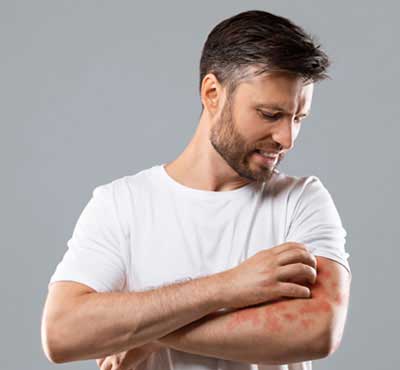What are Viral Infections of the Skin?
As mentioned before, viruses that impact the skin and its substructures are the root cause of viral infections of the skin. They vary from slight, benign issues like common warts to more serious infections like shingles or herpes. Human papillomavirus (HPV), varicella-zoster virus (VZV), herpes simplex virus (HSV), and poxviruses are a few examples of viruses that cause these diseases.
Types of Viral Skin Infections
Herpes Simplex Virus (HSV)
HSV causes cold sores (HSV-1) and genital herpes (HSV-2). The infections are painful blisters or ulcers, which are usually recurrent due to triggers such as stress or a weakened immune system.
Varicella-Zoster Virus (VZV)
VZV causes chickenpox and shingles. Chickenpox is generally a childhood disease that is itchy, red spots, while shingles are a reactivation of the virus in adulthood that causes painful rashes along nerve paths.
Human Papillomavirus (HPV)
HPV causes warts. These include common warts, plantar warts, and genital warts. They are generally benign but can be persistent and cosmetically bothersome.
Molluscum Contagiosum
This poxvirus infection gives dome-shaped lesions that have a central dimple. Very contagious, though this usually resolves over time.
Measles, Rubella & Other Exanthems
The causative agent is a viral infection that causes generalized rashes and systemic symptoms and often requires supportive care and vaccination for prevention.
Clinical features of viral skin infections vary depending on the kind of virus infection but may include:-
- Pink or red rashes with itching.
- Clear fluid-filled blisters, pustules, or lesions.
- Pain, tenderness, or burning sensations in the affected areas.
- Fever, fatigue, or other systemic symptoms if the infection is severe.
- Recurring symptoms in chronic or latent infections, such as herpes or shingles.
Causes & Risk Factors
Viral skin infections are transmitted through direct or indirect contact with the infectious agents. The common modes of transmission include:-
- Direct Contact - Direct skin-to-skin contact with an infected person.
- Indirect Contact - Coming into contact with contaminated objects, like towels or common equipment.
- Weakened Immunity - The person has a weakened immunity that makes him more prone to serious infections.
- Environmental Factors - Some viruses may thrive in warm and moist environments.
Diagnosis at Dermavision - The Skin Clinic
Correct diagnosis is essential to treat the infection and we at Dermavision - The Skin Clinic, through the followingways:-
- Visual Examination - Most viral conditions have a certain characteristic appearance that experienced dermatologists can easily distinguish.
- Laboratory Tests - Skin scrapings, swabs, or blood tests could be carried out to ascertain whether certain viruses exist.
- Biopsy - In a few cases, a small bit of skin can be taken through a microscopic investigation to eliminate all other diseases.


